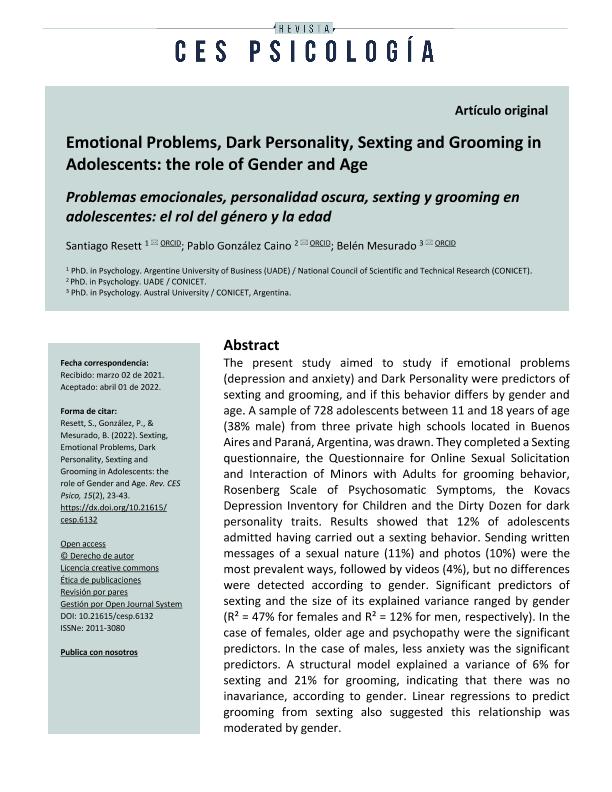Artículo
The present study aimed to study if emotional problems (depression and anxiety) and Dark Personality were predictors of sexting and grooming, and if this behavior differs by gender and age. A sample of 728 adolescents between 11 and 18 years of age (38% male) from three private high schools located in Buenos Aires and Paraná, Argentina, was drawn. They completed a Sexting questionnaire, the Questionnaire for Online Sexual Solicitation and Interaction of Minors with Adults for grooming behavior, Rosenberg Scale of Psychosomatic Symptoms, the Kovacs Depression Inventory for Children and the Dirty Dozen for dark personality traits. Results showed that 12% of adolescents admitted having carried out a sexting behavior. Sending written messages of a sexual nature (11%) and photos (10%) were the most prevalent ways, followed by videos (4%), but no differences were detected according to gender. Significant predictors of sexting and the size of its explained variance ranged by gender (R = 47% for females and R = 12% for men, respectively). In the case of females, older age and psychopathy were the significant predictors. In the case of males, less anxiety was the significant predictors. A structural model explained a variance of 6% for sexting and 21% for grooming, indicating that there was no inavariance, according to gender. Linear regressions to predict grooming from sexting also suggested this relationship was moderated by gender. El presente estudio tuvo como objetivo estudiar si los problemas emocionales (depresión y ansiedad) y la Personalidad Oscura eran predictores del sexting y el grooming, y si este comportamiento varía según el género y la edad. Se constituyó una muestra de 728 adolescentes entre 11 y 18 años (38% hombres) de tres escuelas secundarias privadas ubicadas en Buenos Aires y Paraná, Argentina. Completaron un Cuestionario de sexting, el Cuestionario de Solicitación e Interacción Sexual a menores online por parte de adultos para evaluar el comportamiento de grooming, la Escala de síntomas psicosomáticos de Rosenberg, el Inventario de depresión de Kovacs para niños y el Dirty Dozen para los rasgos de Personalidad Oscura. Los resultados mostraron que 12% de los adolescentes admitió haber padecido una conducta de grooming. Las formas más frecuentes fueron el envío de mensajes escritos de carácter sexual (11%) y fotos (10%) y luego, en orden de frecuencia, el envío de videos (4%), pero no se detectaron diferencias por género. Los predictores significativos de sexting y el tamaño de su varianza explicada variaban según el género (R² = 47% para mujeres y R² = 12% para hombres, respectivamente). En el caso de las mujeres, mayor edad y puntajes de psicopatía fueron predictores significativos, y en el de los hombres, menor ansiedad fue el predictor significativo. Un modelo estructural explicó una varianza del 6% para el sexting y 21% para el grooming, indicando que no hubo invarianza, según el género. Las regresiones lineales para predecir el grooming a partir del sexting también sugirieron que el género moderaba esta relación.
Emotional problems, dark personality, sexting and grooming in adolescents: the role of gender and age
Título:
Problemas emocionales, personalidad oscura, sexting y grooming en adolescentes: el rol del género y la edad
Fecha de publicación:
05/2022
Editorial:
Universidad CES
Revista:
CES Psicología
e-ISSN:
2011-3080
Idioma:
Inglés
Tipo de recurso:
Artículo publicado
Clasificación temática:
Resumen
Archivos asociados
Licencia
Identificadores
Colecciones
Articulos(SEDE CENTRAL)
Articulos de SEDE CENTRAL
Articulos de SEDE CENTRAL
Citación
Resett, Santiago Alejandro; Gonzalez Caino, Pablo; Mesurado, Maria Belen; Emotional problems, dark personality, sexting and grooming in adolescents: the role of gender and age; Universidad CES; CES Psicología; 15; 2; 5-2022; 24-43
Compartir
Altmétricas




